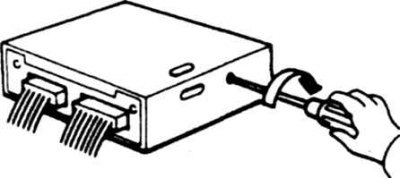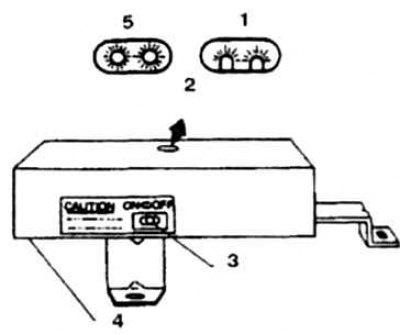Attention! On cars after 1996, diagnostics of failures in the fuel and auxiliary systems is carried out only in a car service. There are no LED indicators on these vehicles.
Failure of sensors and actuators can be determined using the diagnostic codes of the vehicle's ECCS processor system. There are 5 modes of operation of the self-diagnosis system.
Mode 1 - signals from the oxygen sensor. On a warm engine, the closed-loop automatic control mode operates. In this case, the green light is on to indicate a lean mixture or off to indicate a rich mixture. On a cold engine, regulation is performed in an open loop, the indicator either constantly lights up or goes out.

6.1 Mode setting
Mode 2 - tracking feedback when stabilizing the stoichiometry of the mixture. When the composition of the mixture stabilizes within certain limits, the red indicator flashes simultaneously with green. During open-loop control, the red indicator is permanently on (or off).
Mode 3 - self-diagnosis mode. All failures are memorized. The contents of the memory are erased after 50 starts of the starter or when the power supply to the processor unit is interrupted.
Mode 4 - diagnostics of the state of the throttle switches, starter, vehicle speed sensor, etc.
Mode 5 - Real-time diagnostics for on-the-road testing.
Mode selection (engine with direct fuel injection system, 1990-1995)
Turn on the ignition and turn the mode switch clockwise (photo) to failure, wait for the lamp to start flashing. After the number of flashes of the lamp becomes equal to the number of the selected mode, immediately turn the mode switch counterclockwise. Do not turn off the ignition, otherwise mode 1 will be automatically set.

6.2 Move the switch to the left to set the mode
1. Side view; 2. Observation window for signal lamps; 3. Mode switch; 4. Processor block; 5. Top view
To check the codes, warm up the engine and set mode 3. To determine the code, count the number of flashes of the green and red lamps (number of units and tens, respectively). When finished, delete the contents of the memory by turning the switch clockwise (by setting mode 4), and then counterclockwise.
Diagnostic codes and their corresponding faulty circuits and sensors
| 11 | crankshaft angle sensor circuit |
| 12 | Flow meter circuit |
| 13 | Temperature sensor circuit |
| 14 | Speed sensor circuit |
| 21 | Ignition signal circuit |
| 31 | Processing unit |
| 32 | Failure of the recirculation system |
| 33 | Oxygen sensor |
| 34 | Knock sensor |
| 35 | Exhaust gas temperature sensor |
| 41 | Air temperature sensor |
| 43 | Throttle sensor |
| 45 | Leak in nozzle |
| 51 | Injector circuit |
| 55 | Normal operation of the onboard processor |
Selecting a mode on an engine with a pre-injection system (with TBI system)
If necessary, define the mode code (e.g. in the event of a sudden deterioration in engine performance) remove the processor unit from under the passenger seat. Do not disconnect the connectors as the stored codes will be destroyed. Turn the ignition on and move the mode selector switch to the on position (photo) the red and green indicators will flash. After 3 flashes of indicators (mode 3 is set), turn the switch off. To determine the code, count the number of flashes of green and red lamps (number of units and tens, respectively).
When finished, delete the contents of the memory by setting mode 4, or by disconnecting the battery from the ground. When set to mode 4, the indicators should flash 4 times.